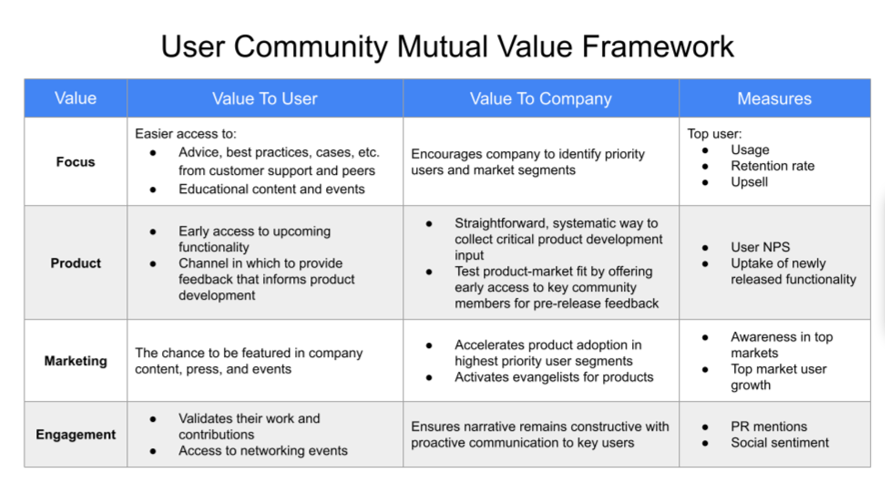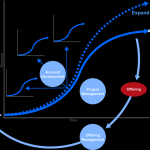Once there are more users of your company’s product than you can keep in touch with individually on a regular basis, it is likely time to implement a community engagement strategy.
The primary objective of a community strategy is to engage a high-priority subset of users in a forum that enables them to connect with each other and your team to benefit themselves and your company. Turning a segment of users into a community is particularly important when you care about their loyalty, and when you want to increase the number of such users.
Before creating a user community, determine who will play the following two key roles:
- Community Manager: The person responsible for developing, driving, communicating, evaluating, and reporting on the plan of actions applied to an assigned community. This person should be able to develop relationships with active community members, understand their pain-points and successes, and do what it takes to enable their community to be successful, such as advocating that internal team members prioritize new product features needed by the community and creating educational materials for community members to use the product most effectively.
- Communities Director: The person responsible for a portfolio of communities and community managers. Provides feedback and guidance to, and develops, community managers to reach their potential to perform and grow. This person should be a strategic thinker and an inspiring leader who understands community dynamics and company business needs. They should work with the community managers to set goals, monitor performance against goals, evaluate performance, and advocate for support by others at the company to increase the odds of achieving community goals.
Then, together with organization leadership, those in these roles should identify the following:
- Goal: Identify the market segment to engage as a community. and select a combination of User and Company values from the Mutual Value Framework above to address.
- Strategy: Select the platform on which to engage with users (e.g. Facebook, Discord, email, etc) and your approach (e.g. provide educational materials, enable peer to peer learning opportunities, seek product feedback, etc) to optimize value for users and your company in the community.
- Plan: A set of actions with assigned resources to accomplish a specific set of results in a timeframe to execute the strategy.
Follow these six steps of an agile process to develop a high-functioning user community:
- Identify: Define a group of current users of the company’s product that are similar in one or more meaningful ways (e.g. language spoken, location, culture, skills, applications, industry, etc.) in a market segment critical to the business (i.e. the market is highly profitable with high growth potential).
- Recruit: Reach out to users in the target segment with an invitation to join the user community through your chosen communication channel(s).
- Engage: Execute the plan of actions intended to create affinity and belonging (e.g. exclusive events, forums for discussion, beta testing opportunities, educational programs) and that drive the chosen value for both the company and community members. Engagement models will differ based on goals and community size. It may be best to engage a small number of users in a deep way and a larger number of users in scaled forums.
- Measure: Calculate the value created for both the community members and the company (e.g., increased sales due to community-driven product improvements, higher retention rates, higher engagement, etc.) and drive a plan of action to achieve targeted results in a time frame.
- Review: Iteratively review progress toward goals. Consider what was supposed to be done, what was done, what happened, what was learned, and what will be done next to achieve targeted results. Share successes, lessons learned, plans, and concerns with the community and internally.
- Iterate: Review community goals and identification criteria for community member participants and iterate on your company’s community strategy. Restart at either step 1 (if your target segment has changed) or 3 to achieve updated goals.
Illustrative Example
A Global Content Crowdsourcing Platform
Background
The company had thousands of contributions from users on its site. Communities of users were naturally developing, since people with expertise on a given topic area were likely to share their content with others in the same topic area.
What was happening amounted to organic marketing which was of great value to the company because when additional people in that topic area wanted to contribute relevant content, they were more likely to turn to the company they already knew for their needs.
The company could have let communities continue to evolve organically, but thought that good things would happen even better and faster with a thoughtful investment in community development.
Goal: Expedite amount of content contributed in top priority vertical market segments.
Strategy: Deliver mutual value to top priority verticals through highly targeted community engagement including scaled data and conversations with top priority contributors in priority segments.
Plan: Proactively stimulate growth and engagement in targeted industry vertical market segments by taking actions such as the following:
- Identify five high-value user segments defined by industry.
- Assign a community manager to each of the topic areas.
- Charter community managers to evangelize the company to those in their segment and to set goals for recruiting both a small number of high volume contributors that they personally cultivate as well as large numbers of smaller contributors through relevant scaled channels such as publications, conferences, influencers, marketing campaigns, etc.
Result
- Value to Users: The vertical community managers developed and disseminated tailored educational material and customer support in the verticals. They facilitated peer-to-peer relationships and learning in their verticals. They worked 1:1 with top priority contributors to ensure the company met their needs.
- Value to Company: Retained top priority contributors, informed product development in top priority segments and influencer-led growth through industry word-of-mouth. Ultimately, the company became a household name in the targeted verticals.
Review
Top priority NPS and penetration improved in top three targeted market segments. The two other segments struggled to grow and engage despite community engagement.
Iterate
Top priority markets were redefined, decreasing focus on the two under-performing segments and increasing investment on the top three segments, resulting in their improved NPS and significantly increasing engagement and growth rate.
Contact us to explore how community development can generate mutual value for you and your users!
About the Author
 Breanna DiGiammarino Breanna DiGiammarino has 15+ years experience working with communities at Meta, Indiegogo and the Draper Richards Kaplan Foundation. She uses the process described in her post to evolve product offerings. Reach her on LinkedIn to keep the communities conversation going!
Breanna DiGiammarino Breanna DiGiammarino has 15+ years experience working with communities at Meta, Indiegogo and the Draper Richards Kaplan Foundation. She uses the process described in her post to evolve product offerings. Reach her on LinkedIn to keep the communities conversation going!
See also by Breanna:










